
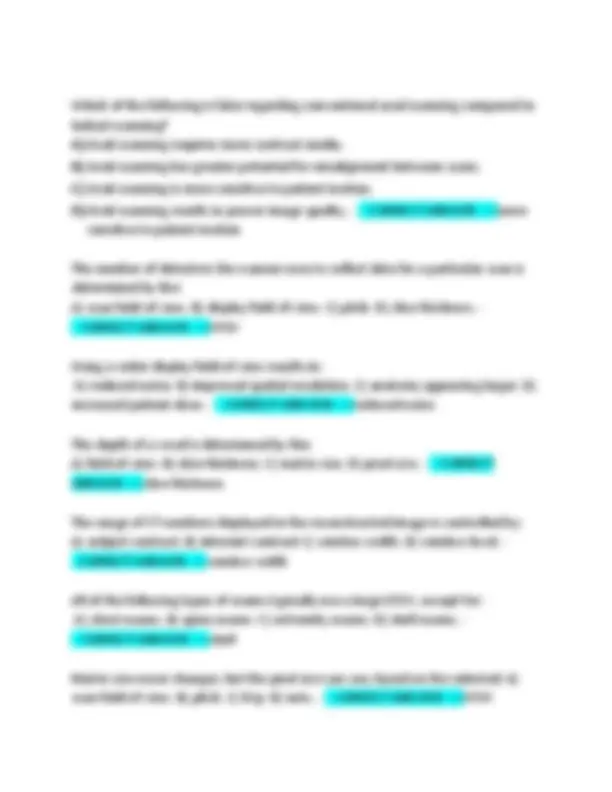
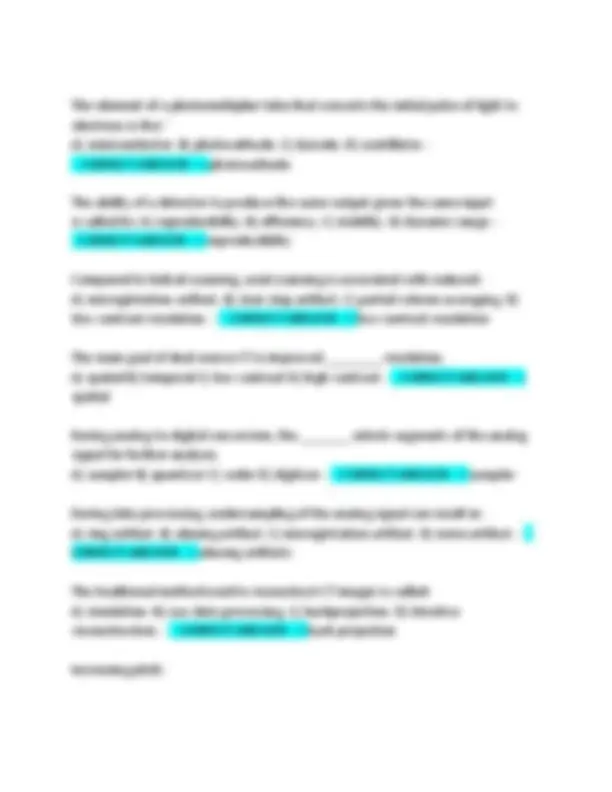
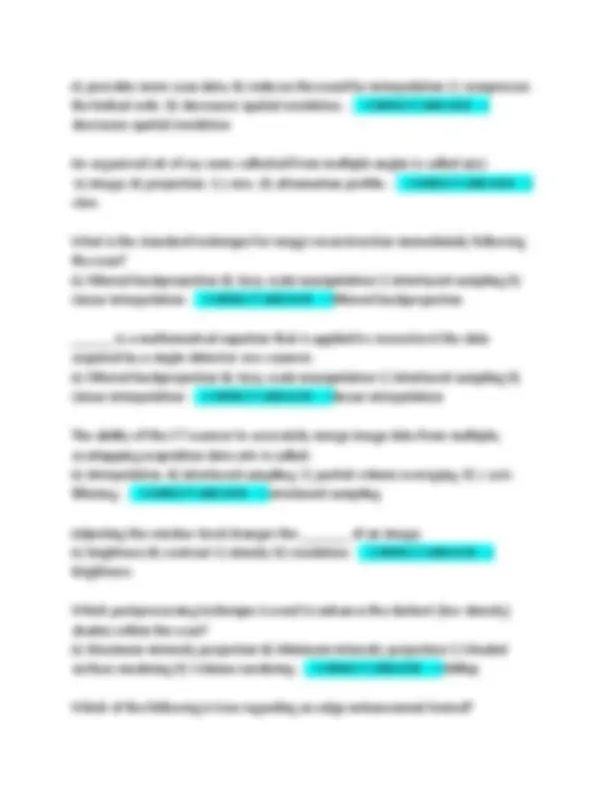
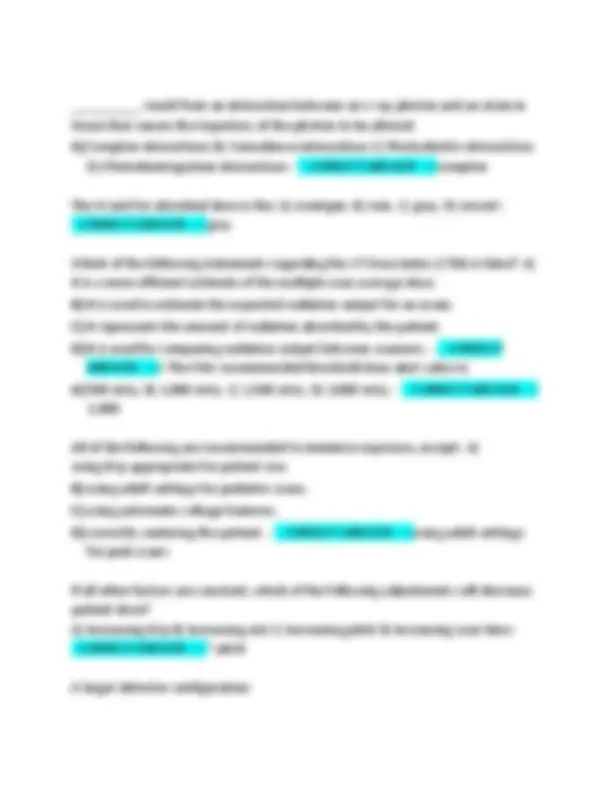
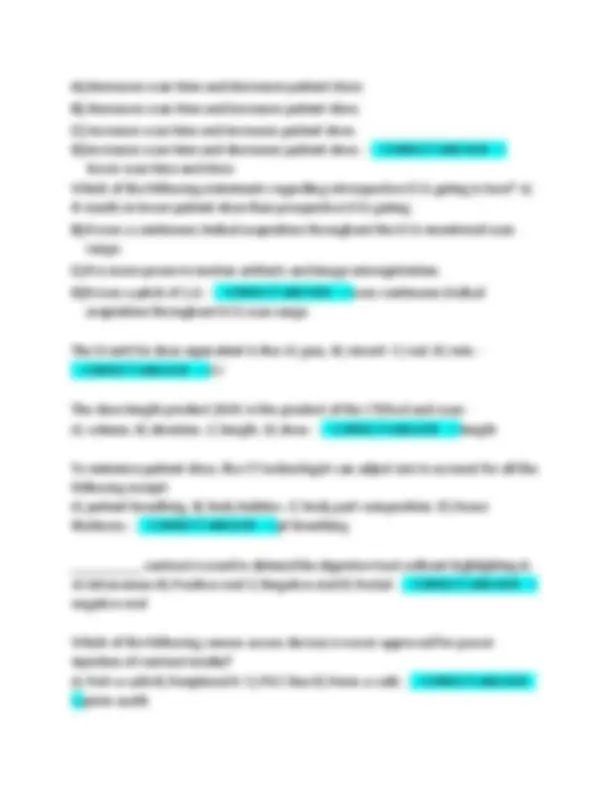
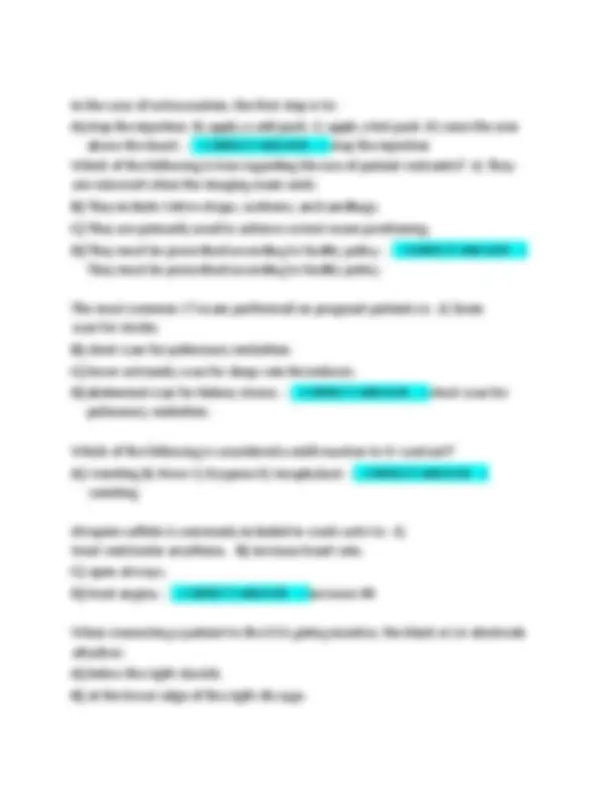
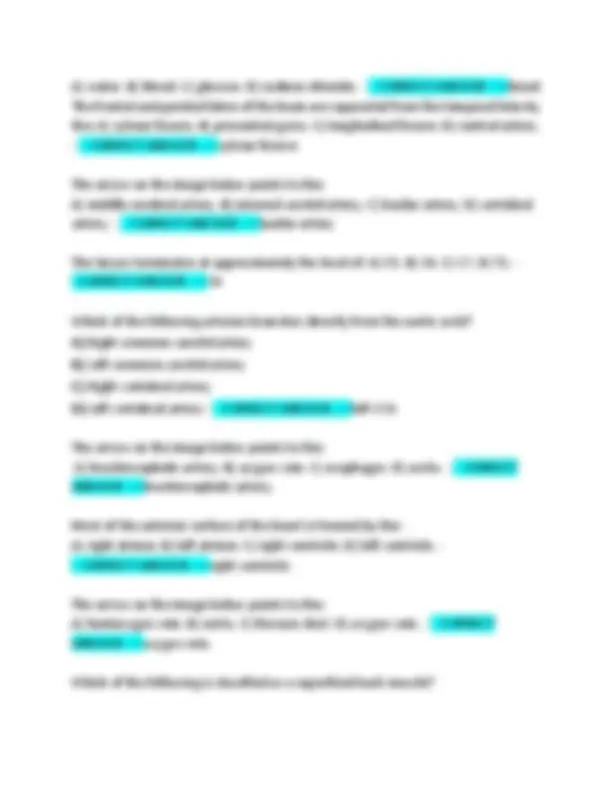
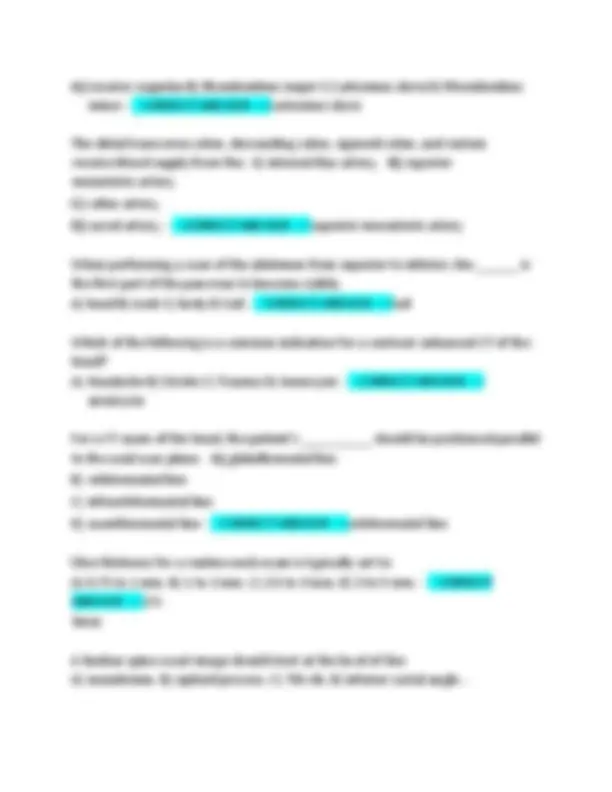
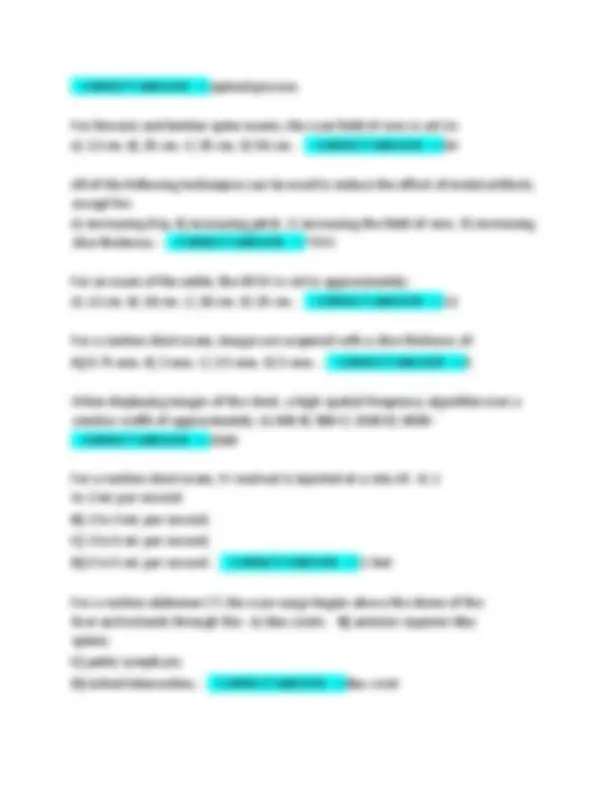
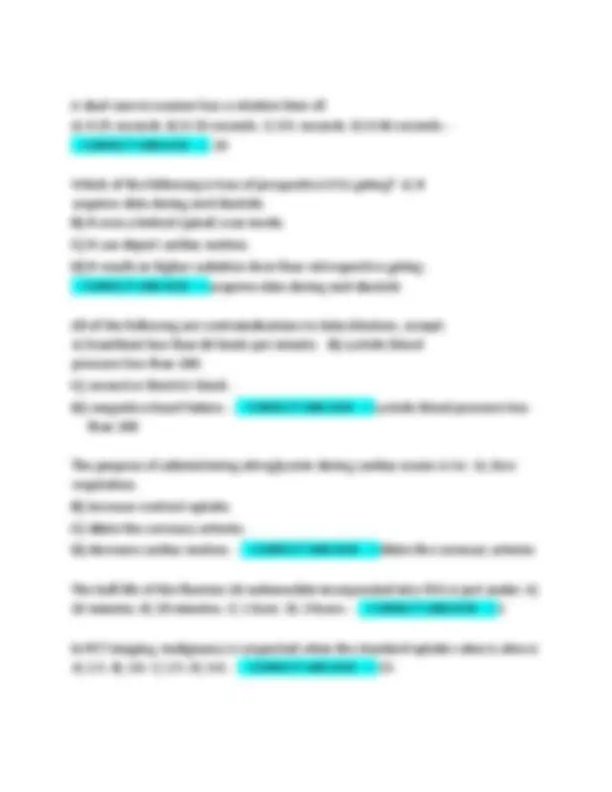
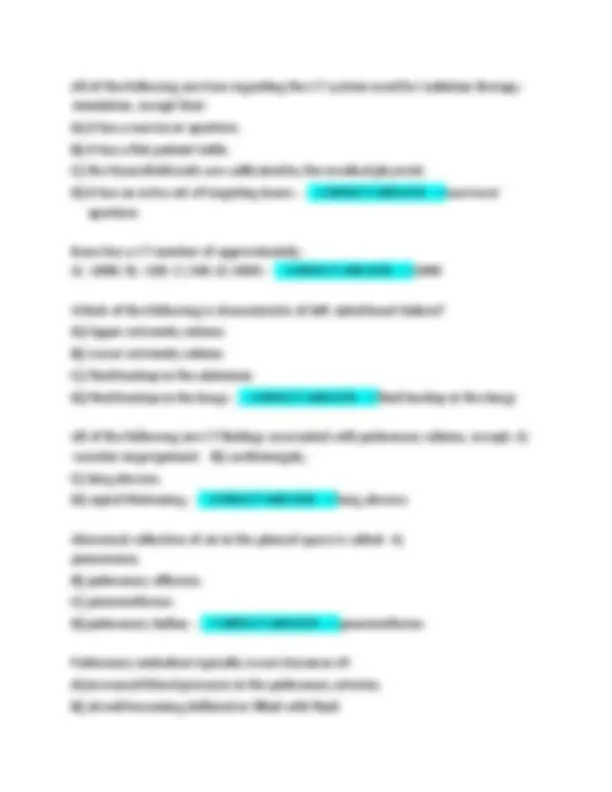
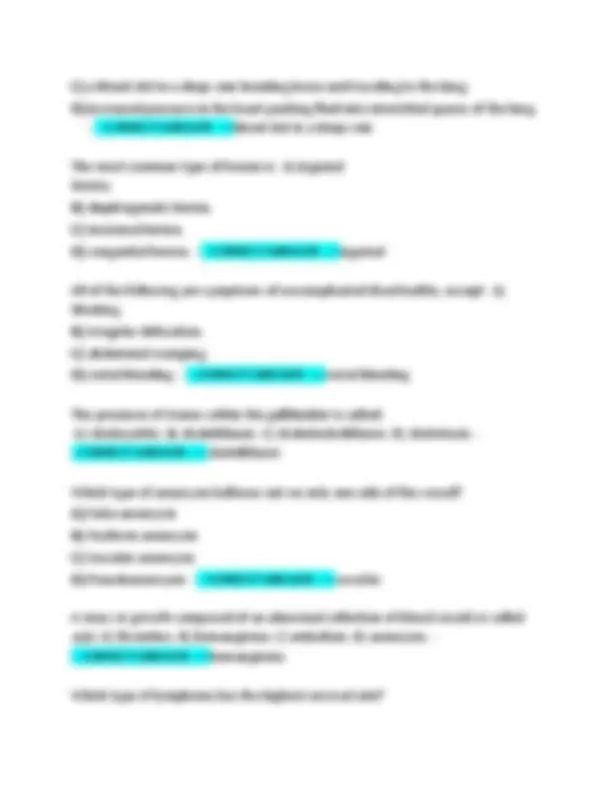
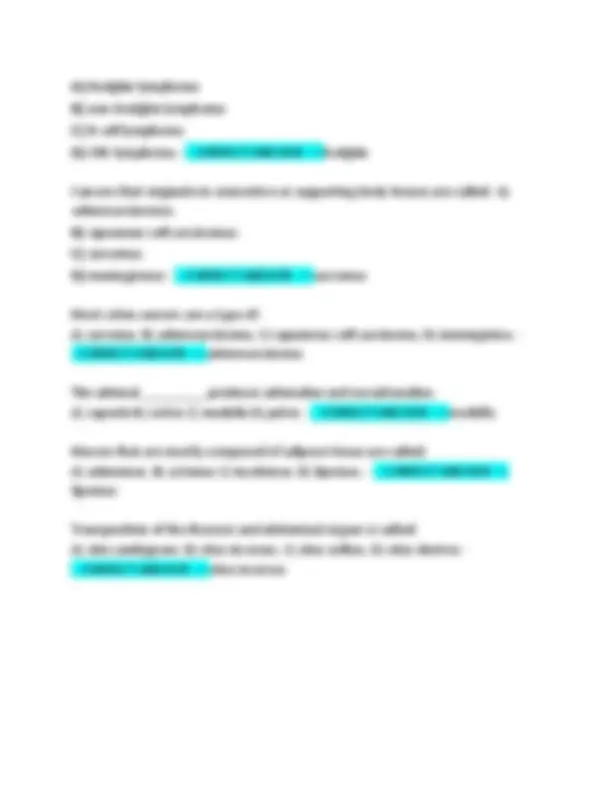


Study with the several resources on Docsity

Earn points by helping other students or get them with a premium plan


Prepare for your exams
Study with the several resources on Docsity

Earn points to download
Earn points by helping other students or get them with a premium plan
Community
Ask the community for help and clear up your study doubts
Discover the best universities in your country according to Docsity users
Free resources
Download our free guides on studying techniques, anxiety management strategies, and thesis advice from Docsity tutors
This document contains the latest verified real questions and correct answers from the 2025 ASRT (American Society of Radiologic Technologists) Exam. It thoroughly covers key topics such as radiographic procedures, patient care, radiation safety, image production, anatomy, positioning, and professional ethics. Ideal for radiologic technology students and professionals preparing for certification with accurate and exam-focused content
Typology: Exams
1 / 21

This page cannot be seen from the preview
Don't miss anything!














Helical scanning motion was first made possible by the unique construction of the ____________ scanner. A) fourth generation B) fifth generation C) sixth generation D) seventh generation
cone beam The ___________ method of data acquisition gathers image data in distinct sections and is sometimes describes as having a "start/stop" motion. A) spiral B) sequential C) helical D) volume - - CORRECT ANSWER - > sequential When pitch is less than 1, the resulting bands of data are: A) adjacent. B) distinct. C) overlapped. D) gapped - - CORRECT ANSWER - > overlapping Which of the following is not a component of the CT gantry? A) X-ray tube B) Array processor C) Slip rings D) Digital acquisition system -
All of the following are characteristics of beam-shaping filters, except: A) they are physical devices. B) they change the spatial distribution of the beam. C) they change the digital appearance of images. D) they remove lower-energy x-rays from the beam. - - CORRECT ANSWER - > they change digital appearance of images The primary data processing component of the CT system is the: A) array processor. B) digital acquisition system. C) PACS. D) amplifier. -
gantry When considering detector efficiency, the measure of how consistently the detectors respond is called: A) capture efficiency. B) absorption efficiency. C) stability. D) response time. - - CORRECT ANSWER - > stability Which component of the CT gantry supplies electrical power to the x-ray tube and transfers the signals from the detectors to the computer? A) Generator B) Slip rings C) Photomultiplier D) Data acquisition system -
The element of a photomultiplier tube that converts the initial pulse of light to electrons is the: ' A) semiconductor. B) photocathode. C) dynode. D) scintillator. -
A) provides more scan data. B) reduces the need for interpolation C) compresses the helical coils. D) decreases spatial resolution. - - CORRECT ANSWER - > decreases spatial resolution An organized set of ray sums collected from multiple angles is called a(n): A) image. B) projection. C) view. D) attenuation profile. - - CORRECT ANSWER - > view What is the standard technique for image reconstruction immediately following the scan? A) Filtered backprojection B) Gray-scale manipulation C) Interlaced sampling D) Linear interpolation - - CORRECT ANSWER - > filtered backprojection ______ is a mathematical equation that is applied to reconstruct the data acquired by a single-detector row scanner. A) Filtered backprojection B) Gray-scale manipulation C) Interlaced sampling D) Linear interpolation - - CORRECT ANSWER - > linear interpolation The ability of the CT scanner to accurately merge image data from multiple, overlapping acquisition data sets is called: A) interpolation. B) interlaced sampling. C) partial volume averaging. D) z-axis filtering. - - CORRECT ANSWER - > interlaced sampling Adjusting the window level changes the _______ of an image. A) brightness B) contrast C) density D) resolution - - CORRECT ANSWER - > brightness Which postprocessing technique is used to enhance the darkest (low density) shades within the scan? A) Maximum intensity projection B) Minimum intensity projection C) Shaded surface rendering D) Volume rendering - - CORRECT ANSWER - > MINip Which of the following is true regarding an edge enhancement kernel?
_______refers to the ability of the CT scanner to consistently assign the same Hounsfield unit number to the same material. A) Reproducibility B) Uniformity C) Linearity D) Stability - - CORRECT ANSWER - > uniformity All of the following result from an increase in mAs, except: A) reduced noise. B) reduced scan time. C) increased x-ray quantity. D) increased patient dose. - - CORRECT ANSWER - > reduced scan time All of the following factors usually increase beam hardening, except: A) thicker anatomy. B) denser structures. C) use of contrast agents. D) use of reconstruction filters - - CORRECT ANSWER - > use of recon filters For __________, all of the anatomy is scanned but only the images acquired during diastole are used. A) prospective gating B) ECG gating C) retrospective gating D) respiratory gating -
__________ result from an interaction between an x-ray photon and an atom in tissue that causes the trajectory of the photon to be altered. A) Compton interactions B) Coincidence interactions C) Photoelectric interactions D) Photodisintegration interactions - - CORRECT ANSWER - > compton The SI unit for absorbed dose is the: A) roentgen. B) rem. C) gray. D) sievert -
In the case of extravasation, the first step is to: A) stop the injection. B) apply a cold pack. C) apply a hot pack. D) raise the arm above the heart. - - CORRECT ANSWER - > stop the injection Which of the following is true regarding the use of patient restraints? A) They are removed when the imaging exam ends. B) They include Velcro straps, cushions, and sandbags. C) They are primarily used to achieve correct exam positioning. D) They must be prescribed according to facility policy. - - CORRECT ANSWER - > They must be prescribed according to facility policy. The most common CT exam performed on pregnant patients is: A) brain scan for stroke. B) chest scan for pulmonary embolism. C) lower extremity scan for deep vein thrombosis. D) abdominal scan for kidney stones. - - CORRECT ANSWER - > chest scan for pulmonary embolism. Which of the following is considered a mild reaction to IV contrast? A) Vomiting B) Hives C) Dyspnea D) Anaphylaxis - - CORRECT ANSWER - > vomiting Atropine sulfate is commonly included in crash carts to: A) treat ventricular arrythmia. B) increase heart rate. C) open airways. D) treat angina. - - CORRECT ANSWER - > increase HR When connecting a patient to the ECG gating monitor, the black or LA electrode attaches: A) below the right clavicle. B) at the lower edge of the right rib cage.
C) below the left clavicle. D) at the lower edge of the left rib cage. - - CORRECT ANSWER - > below left clavicle Which renal function test takes into consideration the patient's age, gender, and race? A) BUN B) Creatinine C) PTT D) eGFR - - CORRECT ANSWER - > eGFR A lower-than-normal prothrombin time indicates: A) increased bleeding risk. B) heart muscle damage. C) slow blood clotting. D) quick blood clotting - - CORRECT ANSWER - > quick blood clotting All of the following are true of high osmolar contrast media, except: A) it does not dissociate in solution. B) it has an osmolality 5 to 8 times higher than blood. C) it is generally less expensive than non-ionic contrast media. D) it has a relatively higher risk of adverse patient reactions. - - CORRECT ANSWER
doesnt dissociate in solution IV contrast is contraindicated in patients with: A) infection. B) acute trauma. C) pancreatitis. D) vascular stenosis -
A) water. B) blood. C) glucose. D) sodium chloride. - - CORRECT ANSWER - > blood The frontal and parietal lobes of the brain are separated from the temporal lobe by the: A) sylvian fissure. B) precentral gyrus. C) longitudinal fissure. D) central sulcus.
A) Levator scapulae B) Rhomboideus major C) Latissimus dorsi D) Rhomboideus minor - - CORRECT ANSWER - > Latissimus dorsi The distal transverse colon, descending colon, sigmoid colon, and rectum receive blood supply from the: A) internal iliac artery. B) superior mesenteric artery. C) celiac artery. D) sacral artery. - - CORRECT ANSWER - > superior mesenteric artery When performing a scan of the abdomen from superior to inferior, the ______ is the first part of the pancreas to become visible. A) head B) neck C) body D) tail - - CORRECT ANSWER - > tail Which of the following is a common indication for a contrast-enhanced CT of the head? A) Headache B) Stroke C) Trauma D) Aneurysm - - CORRECT ANSWER - > aneurysm For a CT exam of the head, the patient's __________ should be positioned parallel to the axial scan plane. A) glabellomeatal line B) orbitomeatal line C) infraorbitomeatal line D) acanthiomeatal line - - CORRECT ANSWER - > orbitomeatal line Slice thickness for a routine neck exam is typically set to: A) 0.75 to 1 mm. B) 1 to 2 mm. C) 2.5 to 3 mm. D) 3 to 5 mm. - - CORRECT ANSWER - > 2.5- 3mm A lumbar spine scout image should start at the level of the: A) manubrium. B) xiphoid process. C) 7th rib. D) inferior costal angle. -
For a CTA of the abdomen and pelvis, the bolus tracking reference location should be placed in the: A) main pulmonary artery. B) aortic arch. C) ascending aorta. D) descending aorta.
All of the following are true of ECG gating for CTA of the aorta, except that it: A) uses a slower pitch. B) results in longer scan times. C) requires more IV contrast. D) is recommended to image the entire aorta. - - CORRECT ANSWER - > is recommended to image the entire aorta. Following liver transplant, the 7-day postoperative liver volume for donors and recipients is approximately: A) 35%. B) 60%. C) 75%. D) 90%. - - CORRECT ANSWER - > 75% The perfusion parameter most closely associated with identifying the volume of brain at risk in an acute infarction is: A) mean transit time. B) time to peak. C) cerebral blood flow. D) cerebral blood volume - - CORRECT ANSWER - > mean transit time The CT dose index volume per scan for CT brain perfusion is approximately _____ of a routine brain scan. A) one-half B) one-fourth C) one-eighth D) onetenth - - CORRECT ANSWER - > 1/ All of the following are true of ablation therapy procedures, except that they: A) have reduced morbidity and mortality compared to surgery. B) do not require sedation or anesthesia. C) can be performed on an outpatient basis. D) can be repeated over time. - - CORRECT ANSWER - > does not require sedation/anesthesia Radiofrequency ablation systems emit high-frequency electrical current in the range of: A) 120 to 260 kHz. B) 340 to 400 kHz. C) 460 to 500 kHz. D) 650 to 710 kHz. - - CORRECT ANSWER - > 460 - 500 Dual-energy CT scans can be obtained simultaneously with acquisitions at 80 kVp and: A) 110 kVp. B) 120 kVp. C) 130 kVp. D) 140 kVp. - - CORRECT ANSWER - > 140
All of the following are true regarding the CT system used for radiation therapy simulation, except that: A) it has a narrower aperture. B) it has a flat patient table. C) the Hounsfield units are calibrated by the medical physicist. D) it has an extra set of targeting lasers. - - CORRECT ANSWER - > narrower aperture Bone has a CT number of approximately: A) - 1000. B) - 100. C) 100. D) 1000. - - CORRECT ANSWER - > 1000 Which of the following is characteristic of left-sided heart failure? A) Upper extremity edema B) Lower extremity edema C) Fluid backup in the abdomen D) Fluid backup in the lungs - - CORRECT ANSWER - > fluid backup in the lungs All of the following are CT findings associated with pulmonary edema, except: A) vascular engorgement. B) cardiomegaly. C) lung abscess. D) septal thickening. - - CORRECT ANSWER - > lung abscess Abnormal collection of air in the pleural space is called: A) pneumonia. B) pulmonary effusion. C) pneumothorax. D) pulmonary bullae. - - CORRECT ANSWER - > pneumothorax Pulmonary embolism typically occurs because of: A) increased blood pressure in the pulmonary arteries. B) alveoli becoming deflated or filled with fluid.
C) a blood clot in a deep vein breaking loose and traveling to the lung. D) increased pressure in the heart pushing fluid into interstitial spaces of the lung.